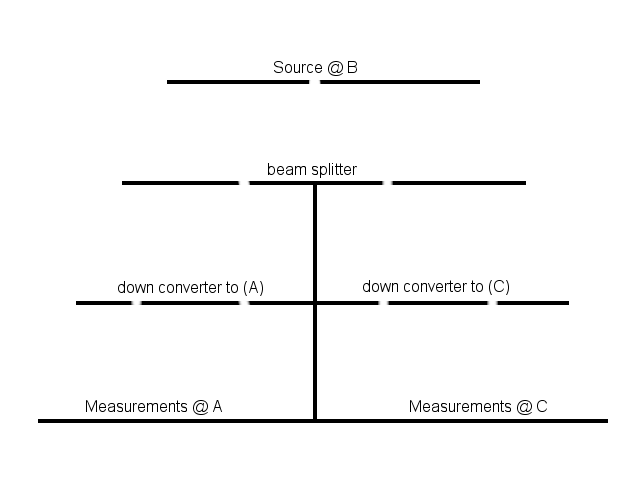-
Posts
101 -
Joined
-
Last visited
Content Type
Profiles
Forums
Events
Everything posted by rajama
-
This is a spin-off from the FTL/entangement thread: I've been reading papers describing a series of undergraduate experiments with entangled photons and they employ laser-fed down-converters to ensure conditions for coincidence counting to work, etc... and, well, doesn't the physical process within the laser cavity itself create entangled photons? I guess I''m thinking the partial reflection of the light produced and the small size of modern lasers (as pointed out in another thread) might produce a variety of entanglements..?
-
I scanned north thinking it was unlikely that someone would find the only one and that it was systematic fault - there may be repeat number..?
-
I think I'm getting tired, but - huh - light doesn't really travel in straight lines in a gravitational field..? It curves, but it does go straight as it crosses the falling elevator (frame), if spacetime (in that volume) doesn't curve too much..? Actually, doesn't time vary way more than space in a weak field like the Earths..? There must be a simple diagram...
-
http://maps.google.com/maps?q=33409&ll=26.899467,-80.074561&spn=0.010772,0.015836&t=k&hl=en Is this another one?
-
Take a look at this reference I didn't really explain fully, hence - perhaps - the confusion: we do have a transducer - the usual kind of cone - fixed to a cabinet or box in the usual way, nothing different from the usual hi-fi design. The purpose of the box is simply to prevent the rear travelling wave interferring with the sound reaching the listener from the front of the cone. With hi-fi (so I'm told by various texts) the problem is that the box makes noises. It stores sound energy for a relatively long after the speaker cone has stopped moving. This causes all kinds of problems, especially when you've spent a lot of time and effort making the speaker cone behave itself (choice of materials, motor selection, etc.). So, we want to cut down the output of the rear of the cone. We can't dump the box, and we can't make it smaller, as it provides most of the suspension for the cone and it needs to have a specific volume, but what we can do is reduce the energy stored by the volume and increase the speed with which it is dispersed by the cabinet. Sorry jdurg, I only mentioned sound speed before, to keep things simple [mistake], but yes of course Heliums density is as importent here: the product of the density and the sound speed determine the specific acoustic impedence of the gas, and this is the governing physical term in the equations relating to the efficiency of the rear of the cone as a transducer... There's a lot more, but that covers the points made above... or does it? Have I missed something?
-

Faster than light communication through entanglement
rajama replied to bascule's topic in Quantum Theory
-

Faster than light communication through entanglement
rajama replied to bascule's topic in Quantum Theory
Thanks for that (been sick, just getting back now) - really useful. Most of the experiments I've read to do with entanglement don't go beyond the demonstration of the underlying QM - that makes this interesting... So, you have a single photon distributed over the whole experiment... until it's detected. It will only ever arrive on one side or the other - that is correct? Also, returning to my post #9, this implies you could move the down converters out to A and C and get the same result - whatever that is? -

Faster than light communication through entanglement
rajama replied to bascule's topic in Quantum Theory
Okay, I assumed two down converters here..? (should it be 'either' or 'each'? This is what confused me in the first place, I guess...) -

Faster than light communication through entanglement
rajama replied to bascule's topic in Quantum Theory
Okay, thanks - er - I think. When I first read #1, it looks as if I didn't pick-up on all of the (implicit) detail of the idea (also, re-reading my post #2 I think I was more than a little 'off' in trying to give advice - huh, foot-in-mouth again). So - after returning to old text books and thrashing Google for useful technical details - a further (still dim, but longer) question: The laser light driving the down converters goes through a beam splitter, so we can't do any kind of coincidence counting... we're looking at a single measurement of a non-local photon 'somewhere' at A or C, and some kind of averaging of the results over time to detect interference (or the lack of): is that correct, or have I missed something else? -

Faster than light communication through entanglement
rajama replied to bascule's topic in Quantum Theory
Can I ask a dim question? Wouldn't this setup - as described so far - still be the same if you moved the down converters out from B to A and C..? -
I can never get incantasions right and as for curses, they always go pair shaped...
-
Some of the people I work with spent an awful lot of time leading up to the millenium working on the Y2K problem, mostly dealing with bespoke [financial] systems running in mainframe environments... and they did their job. Everything was fine. In some companies, these systems had been around for decades, the programmers who wrote them had moved on or retired, and system documentation was variable. But then, checking millions of lines of code is fun - isn't it? I understand this kind of system can be the most valuable asset a company will have, so even a hint that something might undermine it... well, you can see how people got worried. Sure, the hype was - well - hype, but someone somewhere had to assess each and every system. I understand that - mostly - the problem was not only how dates were represented, but how the original programmer chose to calculate the difference between two dates. And then, of course, there's what happens in leap years, and the exceptions... Nothing fell out of the sky that I know of, and very few gliches were reported that I remember. But then, they wouldn't be... would they?
-

Faster than light communication through entanglement
rajama replied to bascule's topic in Quantum Theory
Your set-up seems - to me - a little vague. I've only been here a short while, but I would guess you need more initial detail to engage the members here who can actually comment on it with any authority. Maybe the same again, with more on the mechanism at B and the logic regarding how you can tell the interference pattern exists, etc. Just a thought. Have fun. -
I liked the movie as a movie - not sure about the opening musical number. I miss the radio show narration- I always thought the voice of the book was Douglas Adams...
-
I used to get deja vu in school, usually while waiting around for next class - something would happen and I already know what the order of events would be just before each occured. I think this is the 'classic' case, where the time difference isn't really quantifiable, the one that is usually given as an example that supports the idea of some kind of perceptual delay or loop. I don't know if the examples that begin this thread really fall under the heading 'deja vu' - maybe prophetic [but boring] dreams?
-
Got to admit, I've taken the day off Friday to see it. Bill Nighy is Slartibartfarst! You know, I just searched on Slartibartfarst and Google corrected my spelling...
-
Where are the threads that mention the 'excision method'? Can't find a reference to 'excision'... Tried to google 'excision time travel' and ended up with this thread... huh
-
Isn't the 'beam' just the light that's left over after being reflected back and forth many many times in the laser cavity, a bit like a regular light source travelling a long way through a series of small, aligned holes?
-
I got the impression that time machines theorised by (say) Tipler or Thorne conserve mass etc. at their 'entry' and 'exit' points. Remember, only the traveller witnesses the journey...
-
I just re-read my post #6 above and... well, it doesn't make an awful lot of sense. Lets just say that maybe these devices probably generate a lot of ions that don't get neutralised, and back quietly away from the thread...
-
It may be a little late to butt-in on this thread, but this link may be useful: http://www.atmo.arizona.edu/faculty/research/lightning/ 5th paragraph mentions power levels of 10,000 megawatts but implies we have no precise knowledge of the energy available
-
Many thanks... Okay, so there's a fault at present with the research paper link and the last link describes a lensless 2D projector using a hologram to simulate the output of a whole optical system - which is cool - but the second example looks like it can provide VR for one eye..? The real image application mentioned in the 2nd link raises the old issue of what to do with the light once it reaches the point it should 'be at' [a gel?] but it looks like it would project a hologram in the traditional SF sense. Fun.
-
What if we divide the journey into a thousand billion steps? What if we send back a qubit?
-
An idea I had some time ago... The idea is reduce energy storaged internally by a loudspeaker - we do this by making it acoustically 'smaller'. The speed of sound in helium is nearly three times that in air at sea level & around 20c [hmmm - need to check that] so this makes the volume of the cabinet act like an acoustic spring through most of the range over which the mid-low driver operates, as standing waves can now only occur at a higher frequency [for a compact enclosure these would cut-in at around 2kHz instead of 700Hz]. This also speeds up the dissemination of energy by the cabinet, reduces reflected sound passing out thru the driver cone, and a host of other useful things... when you actually hit a standing wave mode for the cabinet, the energy stored is something like -4dB lower than with air, and at higher frequencies, as wavelength shortens and the interior takes on a 3 dimensional acoustic charactor, the efficiency of the driver falls away, by something like -16dB. This is all based on some shaky calculations I did 20 years ago, so... and I haven't even gotten into the thermal implications and reduced audio compression! Dull, isn't it. I thought it might be a fairly obvious thing to try, yet I've seen no commercial examples, not even DIY. Since the idea exploits the properties of a gas, I imagine the patentable part would be in sealing the cabinet and driver, but as helium is usually used to check for leaks... no I haven't built one. Anyone seen anything like this?


